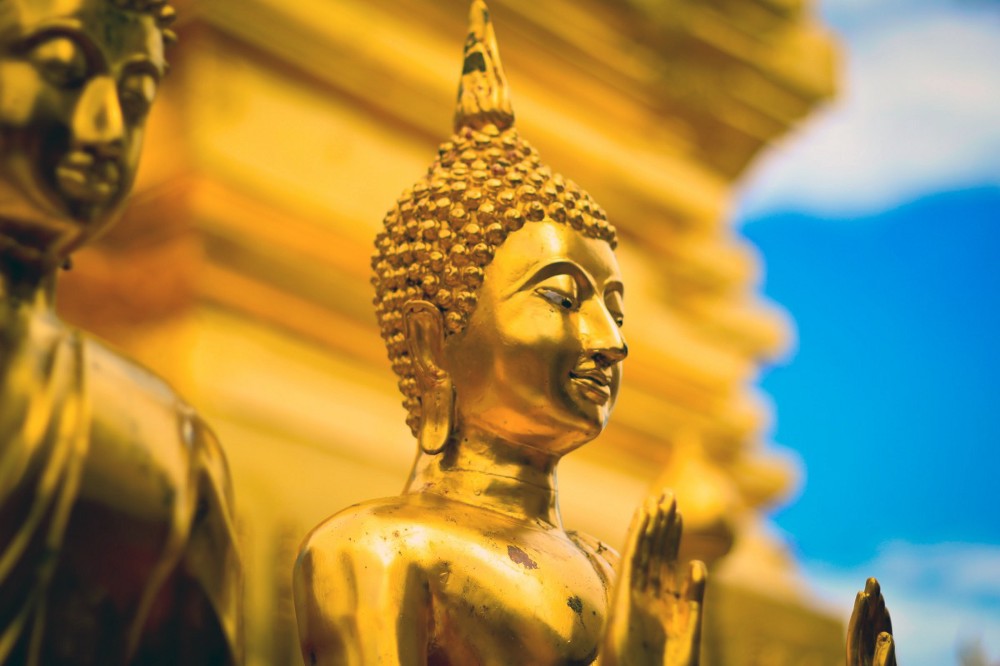Despite the Republican Party’s insistence that anyone who struggles to pay the bills must be lazy, Americans are a striving bunch. Not because of anything essential about us, but because of the way our society is organized. Capitalism forces those not lucky enough to be born wealthy to spend more time working for a living than enjoying that living. We have no choice but to hustle.
So, it makes sense that, in American Buddhist circles, teachings about the historical Buddha often solely focus on one chapter of his life. As the story goes, after leaving his noble family’s palace for the first time, the soon-to-be spiritual master encountered four people — one sick, one old, one dead, and one a monk — who so awakened him that he renounced civilized life to pursue a path of becoming enlightened, awakened for good.
This heroic search for meaning resonates with our conditioning, motivating us to deepen our own search. Suffering is all there is, we learn, so we better grit our teeth and get to work. One day, with enough money, time, love, mindfulness, or whatever we’re searching for, maybe we’ll finally feel fulfilled.
But what happened next is just as enlightening, even more so for those of us who strive. For six years, the Buddha wandered forests and jungles practicing intense forms of meditation and austere living. Alongside other yogis, he tortured his body to try to overcome its desires and needs, eventually limiting his daily diet to a few grains of rice. “When I touched my belly, I would feel my backbone, and when I went to urinate, I would fall over,” he would later say.
Eventually, at the edge of death, he realized that starving himself was only causing more suffering. With the help of a peasant woman who gave him milk rice, he recovered and developed the practices and teachings that would soon become known as Buddhism, sometimes called the “Middle Way.”
This second chapter of the Buddha’s life offers two powerful lessons.
First, striving, even in spiritual practice, is yet another form of the grasping that causes our suffering. When we lean into the future, we leave the present moment, which numbs us to our bodies and emotions — which is exactly why we do it.
Feeling things directly is difficult, especially if we’ve experienced severe trauma. So, we develop habits and patterns at an early age to protect ourselves from having to feel intense emotions caused by people we have no control over. But, as adults, the more we try to escape our feelings, the more pressure builds up inside of them, making it more difficult to express them in skillful and creative ways. Our patterns of suffering, samsara, feed into themselves, and around we go, again and again.
Striving is just one of those patterns. It’s a way of convincing ourselves that we’re working hard to end our suffering — to lose 50 pounds, write a novel, reach our goals. But it’s actually how we’ve been conditioned to dodge the hardest but most rewarding work of all, staying engaged right here, right now.
Luckily, the Buddha taught a practice to go along with his theory of human suffering. Meditation calms our mind and produces mindfulness, which helps us notice when we’re trying to escape. Then, with practice, it helps us feel compassion rather than resentment toward our habits. It helps change the way we relate to striving, anger, addiction — to whatever our pattern is.
The other lesson is: we can’t do it all alone. The Buddha didn’t reach enlightenment by himself. He would’ve died trying had it not been for someone else — a peasant woman living in an extremely patriarchal society, at that.
Pretending we can do it all on our own is yet another way we’ve been conditioned as Americans — this time in order to justify and preserve a particular social order. We worship the start-up entrepreneur, the one kid that made it out of a poor neighborhood, or the underdog politician. When people come together to make collective demands, say through a union, they’re denounced as “activists” with an “agenda,” or worse, crushed by the powerful, often using the government.
Ironically, this do-it-yourself mentality is what underpins racism, sexism, and other forms of oppression. Women who want equality should just “lean in,” i.e., strive harder to get to the top. Black people who end up in jail deserve their punishment because they chose to commit a crime — not because of skyrocketing economic inequality and hundreds of years of racism.
Not only did the Buddha need help to save him from an early death, but he would go on to include sangha, or community, as one of the ideals at the heart of Buddhism, known as the Three Refuges.
We can’t do it alone — thinking otherwise is just a fantasy.
Both striving and the do-it-yourself mentality are as American as apple pie. When we talk about the Buddha’s life, we shouldn’t skip the second chapter, which has so much to offer to our lives in these times.
Ready to get serious about meditation?
Sign up for my weekly email on meditation and bringing mindfulness to work, relationships, and politics.
Listen to the podcast version
My podcast, Meditation for the Masses, takes meditation out of faraway monasteries, expensive retreat centers, and corporate America, and brings it to the things that matter most to people who work for a living—work, relationships, and politics. It’s mindfulness for the hustle and the class struggle.
Podcast: Play in new window | Download
Subscribe: Apple Podcasts | RSS | More
